HI5017 Managerial Accounting: Costing Systems Analysis Report
VerifiedAdded on 2022/08/27
|12
|3974
|16
Report
AI Summary
This report provides a comprehensive analysis of managerial accounting, specifically focusing on standard costing and target costing. The assignment begins by defining and explaining the features of a standard costing system, highlighting its relevance in identifying cost variances and aiding managerial decision-making, including pricing policies and operational efficiency. The report then examines the relevance of standard costing through a study of the Turkish automotive industry, illustrating its continued use and importance. Subsequently, the report compares and contrasts target costing with standard costing, outlining the target costing method as a tool for determining product life cycle costs and maintaining desired profit margins, especially in competitive markets. The analysis underscores the role of target costing in cost planning, management, and reduction. The report concludes by synthesizing the key concepts and comparing the two costing methods, emphasizing their practical applications in modern business environments.
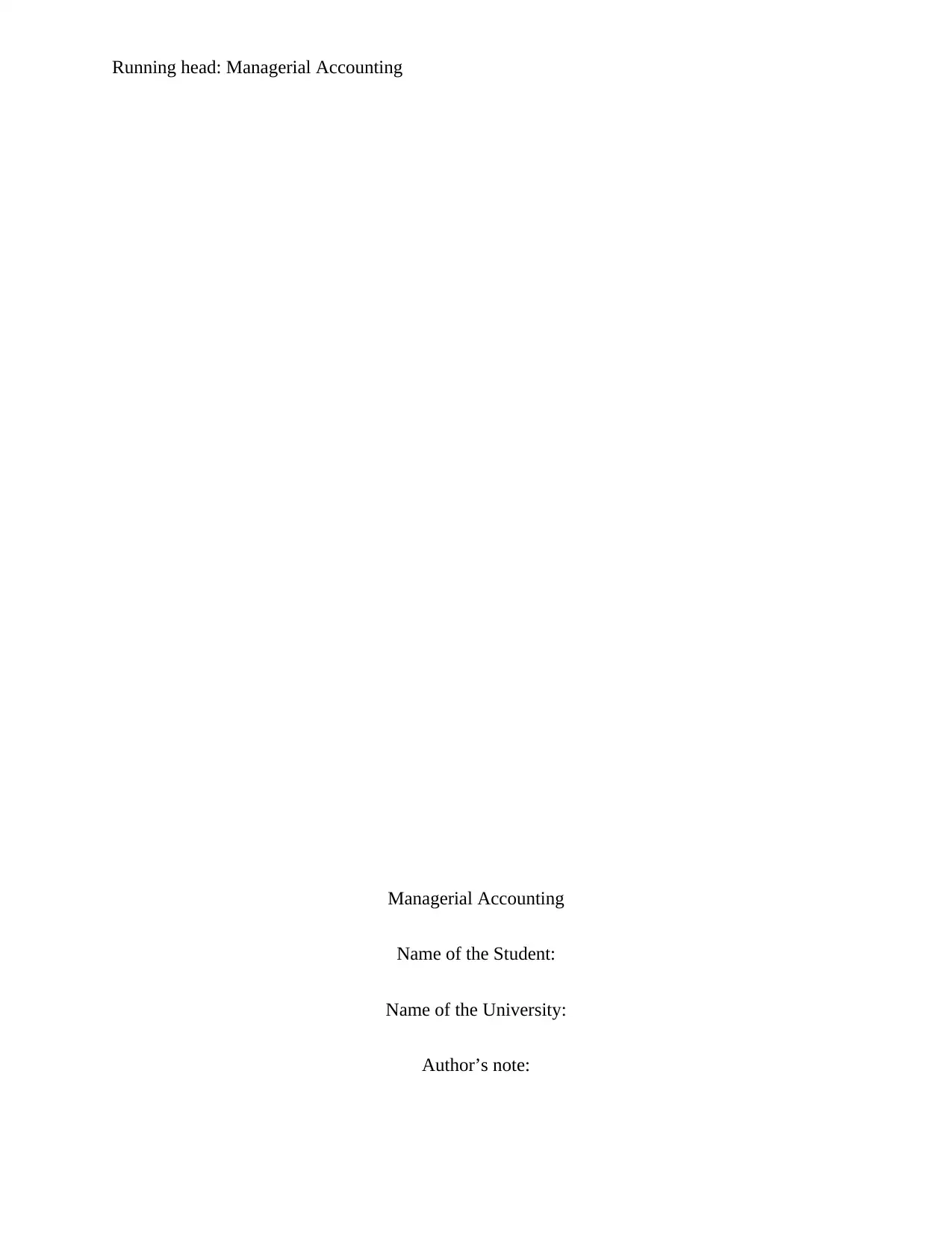
Running head: Managerial Accounting
Managerial Accounting
Name of the Student:
Name of the University:
Author’s note:
Managerial Accounting
Name of the Student:
Name of the University:
Author’s note:
Paraphrase This Document
Need a fresh take? Get an instant paraphrase of this document with our AI Paraphraser

1Managerial Accounting
Abstract
The assignment focuses on critically understanding the concept of standard costing and
target costing. With increase in technological advances and globalization companies
have been using different types of methods instead of calculating standard costing and
target costing. Therefore, he paper tries to reflect the significance and relevance of
standard costing and target costing in the modern day companies. This will be
supported by analyzing two journal articles. At last a relevant conclusion is drawn after
analyzing the two papers.
Abstract
The assignment focuses on critically understanding the concept of standard costing and
target costing. With increase in technological advances and globalization companies
have been using different types of methods instead of calculating standard costing and
target costing. Therefore, he paper tries to reflect the significance and relevance of
standard costing and target costing in the modern day companies. This will be
supported by analyzing two journal articles. At last a relevant conclusion is drawn after
analyzing the two papers.

2Managerial Accounting
Table of Contents
Introduction........................................................................................................................2
Discussion..........................................................................................................................2
Standard Costing System Features...............................................................................2
Relevance of Standard Costing with the Study.............................................................3
Comparison between Target Costing and Standard Costing........................................4
Relevance of Target Costing.........................................................................................5
Conclusion.........................................................................................................................6
Reference..........................................................................................................................8
Table of Contents
Introduction........................................................................................................................2
Discussion..........................................................................................................................2
Standard Costing System Features...............................................................................2
Relevance of Standard Costing with the Study.............................................................3
Comparison between Target Costing and Standard Costing........................................4
Relevance of Target Costing.........................................................................................5
Conclusion.........................................................................................................................6
Reference..........................................................................................................................8
⊘ This is a preview!⊘
Do you want full access?
Subscribe today to unlock all pages.

Trusted by 1+ million students worldwide
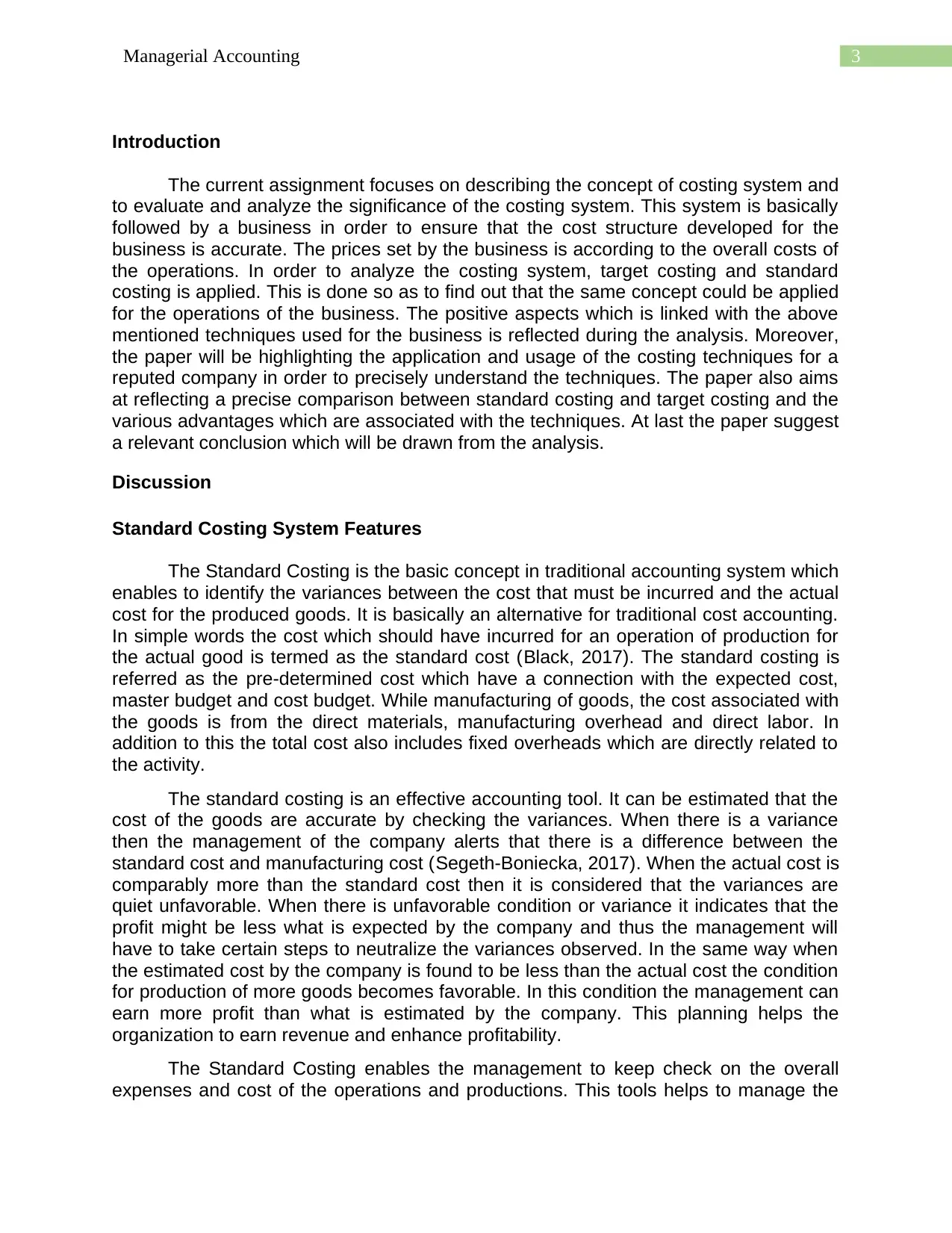
3Managerial Accounting
Introduction
The current assignment focuses on describing the concept of costing system and
to evaluate and analyze the significance of the costing system. This system is basically
followed by a business in order to ensure that the cost structure developed for the
business is accurate. The prices set by the business is according to the overall costs of
the operations. In order to analyze the costing system, target costing and standard
costing is applied. This is done so as to find out that the same concept could be applied
for the operations of the business. The positive aspects which is linked with the above
mentioned techniques used for the business is reflected during the analysis. Moreover,
the paper will be highlighting the application and usage of the costing techniques for a
reputed company in order to precisely understand the techniques. The paper also aims
at reflecting a precise comparison between standard costing and target costing and the
various advantages which are associated with the techniques. At last the paper suggest
a relevant conclusion which will be drawn from the analysis.
Discussion
Standard Costing System Features
The Standard Costing is the basic concept in traditional accounting system which
enables to identify the variances between the cost that must be incurred and the actual
cost for the produced goods. It is basically an alternative for traditional cost accounting.
In simple words the cost which should have incurred for an operation of production for
the actual good is termed as the standard cost (Black, 2017). The standard costing is
referred as the pre-determined cost which have a connection with the expected cost,
master budget and cost budget. While manufacturing of goods, the cost associated with
the goods is from the direct materials, manufacturing overhead and direct labor. In
addition to this the total cost also includes fixed overheads which are directly related to
the activity.
The standard costing is an effective accounting tool. It can be estimated that the
cost of the goods are accurate by checking the variances. When there is a variance
then the management of the company alerts that there is a difference between the
standard cost and manufacturing cost (Segeth-Boniecka, 2017). When the actual cost is
comparably more than the standard cost then it is considered that the variances are
quiet unfavorable. When there is unfavorable condition or variance it indicates that the
profit might be less what is expected by the company and thus the management will
have to take certain steps to neutralize the variances observed. In the same way when
the estimated cost by the company is found to be less than the actual cost the condition
for production of more goods becomes favorable. In this condition the management can
earn more profit than what is estimated by the company. This planning helps the
organization to earn revenue and enhance profitability.
The Standard Costing enables the management to keep check on the overall
expenses and cost of the operations and productions. This tools helps to manage the
Introduction
The current assignment focuses on describing the concept of costing system and
to evaluate and analyze the significance of the costing system. This system is basically
followed by a business in order to ensure that the cost structure developed for the
business is accurate. The prices set by the business is according to the overall costs of
the operations. In order to analyze the costing system, target costing and standard
costing is applied. This is done so as to find out that the same concept could be applied
for the operations of the business. The positive aspects which is linked with the above
mentioned techniques used for the business is reflected during the analysis. Moreover,
the paper will be highlighting the application and usage of the costing techniques for a
reputed company in order to precisely understand the techniques. The paper also aims
at reflecting a precise comparison between standard costing and target costing and the
various advantages which are associated with the techniques. At last the paper suggest
a relevant conclusion which will be drawn from the analysis.
Discussion
Standard Costing System Features
The Standard Costing is the basic concept in traditional accounting system which
enables to identify the variances between the cost that must be incurred and the actual
cost for the produced goods. It is basically an alternative for traditional cost accounting.
In simple words the cost which should have incurred for an operation of production for
the actual good is termed as the standard cost (Black, 2017). The standard costing is
referred as the pre-determined cost which have a connection with the expected cost,
master budget and cost budget. While manufacturing of goods, the cost associated with
the goods is from the direct materials, manufacturing overhead and direct labor. In
addition to this the total cost also includes fixed overheads which are directly related to
the activity.
The standard costing is an effective accounting tool. It can be estimated that the
cost of the goods are accurate by checking the variances. When there is a variance
then the management of the company alerts that there is a difference between the
standard cost and manufacturing cost (Segeth-Boniecka, 2017). When the actual cost is
comparably more than the standard cost then it is considered that the variances are
quiet unfavorable. When there is unfavorable condition or variance it indicates that the
profit might be less what is expected by the company and thus the management will
have to take certain steps to neutralize the variances observed. In the same way when
the estimated cost by the company is found to be less than the actual cost the condition
for production of more goods becomes favorable. In this condition the management can
earn more profit than what is estimated by the company. This planning helps the
organization to earn revenue and enhance profitability.
The Standard Costing enables the management to keep check on the overall
expenses and cost of the operations and productions. This tools helps to manage the
Paraphrase This Document
Need a fresh take? Get an instant paraphrase of this document with our AI Paraphraser
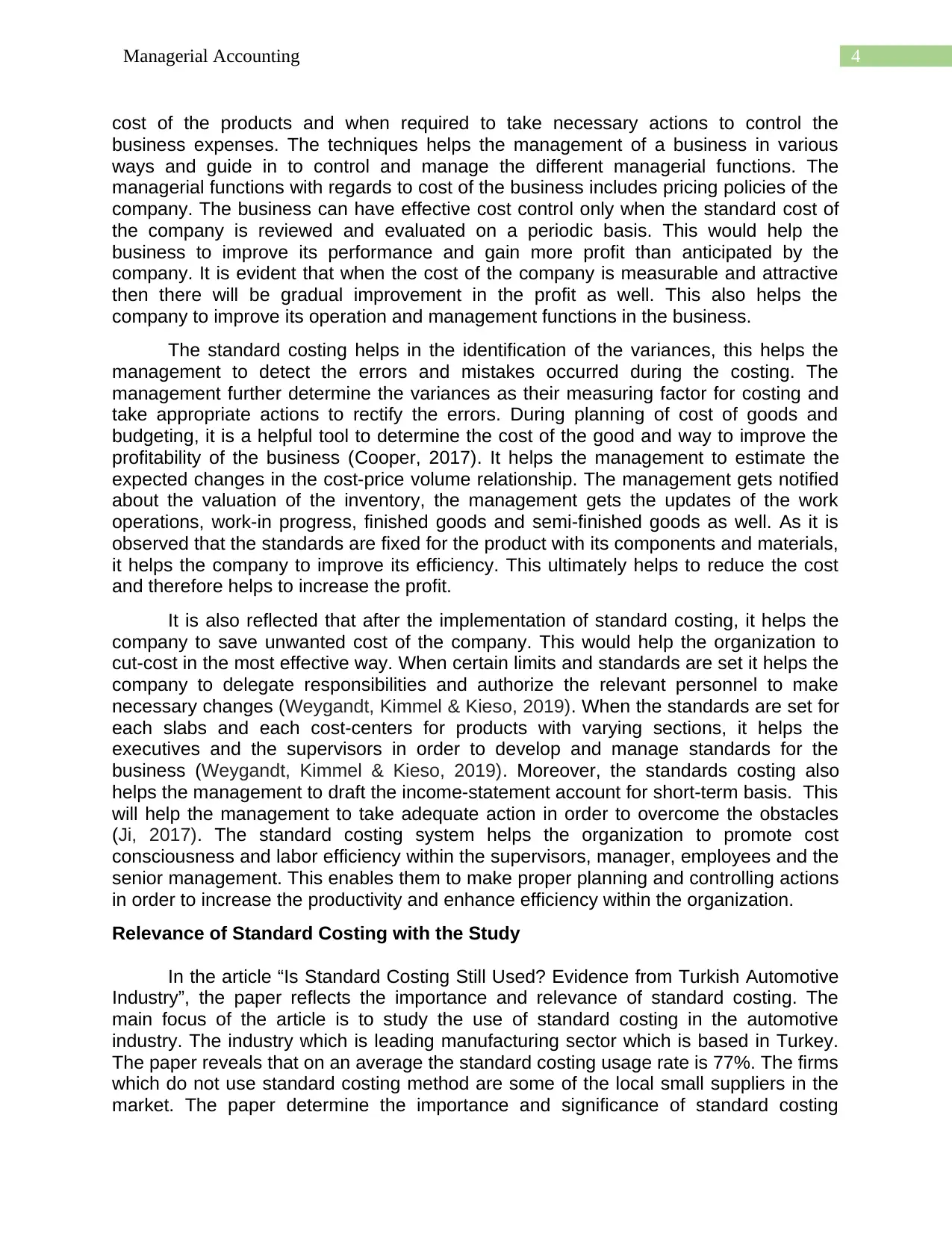
4Managerial Accounting
cost of the products and when required to take necessary actions to control the
business expenses. The techniques helps the management of a business in various
ways and guide in to control and manage the different managerial functions. The
managerial functions with regards to cost of the business includes pricing policies of the
company. The business can have effective cost control only when the standard cost of
the company is reviewed and evaluated on a periodic basis. This would help the
business to improve its performance and gain more profit than anticipated by the
company. It is evident that when the cost of the company is measurable and attractive
then there will be gradual improvement in the profit as well. This also helps the
company to improve its operation and management functions in the business.
The standard costing helps in the identification of the variances, this helps the
management to detect the errors and mistakes occurred during the costing. The
management further determine the variances as their measuring factor for costing and
take appropriate actions to rectify the errors. During planning of cost of goods and
budgeting, it is a helpful tool to determine the cost of the good and way to improve the
profitability of the business (Cooper, 2017). It helps the management to estimate the
expected changes in the cost-price volume relationship. The management gets notified
about the valuation of the inventory, the management gets the updates of the work
operations, work-in progress, finished goods and semi-finished goods as well. As it is
observed that the standards are fixed for the product with its components and materials,
it helps the company to improve its efficiency. This ultimately helps to reduce the cost
and therefore helps to increase the profit.
It is also reflected that after the implementation of standard costing, it helps the
company to save unwanted cost of the company. This would help the organization to
cut-cost in the most effective way. When certain limits and standards are set it helps the
company to delegate responsibilities and authorize the relevant personnel to make
necessary changes (Weygandt, Kimmel & Kieso, 2019). When the standards are set for
each slabs and each cost-centers for products with varying sections, it helps the
executives and the supervisors in order to develop and manage standards for the
business (Weygandt, Kimmel & Kieso, 2019). Moreover, the standards costing also
helps the management to draft the income-statement account for short-term basis. This
will help the management to take adequate action in order to overcome the obstacles
(Ji, 2017). The standard costing system helps the organization to promote cost
consciousness and labor efficiency within the supervisors, manager, employees and the
senior management. This enables them to make proper planning and controlling actions
in order to increase the productivity and enhance efficiency within the organization.
Relevance of Standard Costing with the Study
In the article “Is Standard Costing Still Used? Evidence from Turkish Automotive
Industry”, the paper reflects the importance and relevance of standard costing. The
main focus of the article is to study the use of standard costing in the automotive
industry. The industry which is leading manufacturing sector which is based in Turkey.
The paper reveals that on an average the standard costing usage rate is 77%. The firms
which do not use standard costing method are some of the local small suppliers in the
market. The paper determine the importance and significance of standard costing
cost of the products and when required to take necessary actions to control the
business expenses. The techniques helps the management of a business in various
ways and guide in to control and manage the different managerial functions. The
managerial functions with regards to cost of the business includes pricing policies of the
company. The business can have effective cost control only when the standard cost of
the company is reviewed and evaluated on a periodic basis. This would help the
business to improve its performance and gain more profit than anticipated by the
company. It is evident that when the cost of the company is measurable and attractive
then there will be gradual improvement in the profit as well. This also helps the
company to improve its operation and management functions in the business.
The standard costing helps in the identification of the variances, this helps the
management to detect the errors and mistakes occurred during the costing. The
management further determine the variances as their measuring factor for costing and
take appropriate actions to rectify the errors. During planning of cost of goods and
budgeting, it is a helpful tool to determine the cost of the good and way to improve the
profitability of the business (Cooper, 2017). It helps the management to estimate the
expected changes in the cost-price volume relationship. The management gets notified
about the valuation of the inventory, the management gets the updates of the work
operations, work-in progress, finished goods and semi-finished goods as well. As it is
observed that the standards are fixed for the product with its components and materials,
it helps the company to improve its efficiency. This ultimately helps to reduce the cost
and therefore helps to increase the profit.
It is also reflected that after the implementation of standard costing, it helps the
company to save unwanted cost of the company. This would help the organization to
cut-cost in the most effective way. When certain limits and standards are set it helps the
company to delegate responsibilities and authorize the relevant personnel to make
necessary changes (Weygandt, Kimmel & Kieso, 2019). When the standards are set for
each slabs and each cost-centers for products with varying sections, it helps the
executives and the supervisors in order to develop and manage standards for the
business (Weygandt, Kimmel & Kieso, 2019). Moreover, the standards costing also
helps the management to draft the income-statement account for short-term basis. This
will help the management to take adequate action in order to overcome the obstacles
(Ji, 2017). The standard costing system helps the organization to promote cost
consciousness and labor efficiency within the supervisors, manager, employees and the
senior management. This enables them to make proper planning and controlling actions
in order to increase the productivity and enhance efficiency within the organization.
Relevance of Standard Costing with the Study
In the article “Is Standard Costing Still Used? Evidence from Turkish Automotive
Industry”, the paper reflects the importance and relevance of standard costing. The
main focus of the article is to study the use of standard costing in the automotive
industry. The industry which is leading manufacturing sector which is based in Turkey.
The paper reveals that on an average the standard costing usage rate is 77%. The firms
which do not use standard costing method are some of the local small suppliers in the
market. The paper determine the importance and significance of standard costing
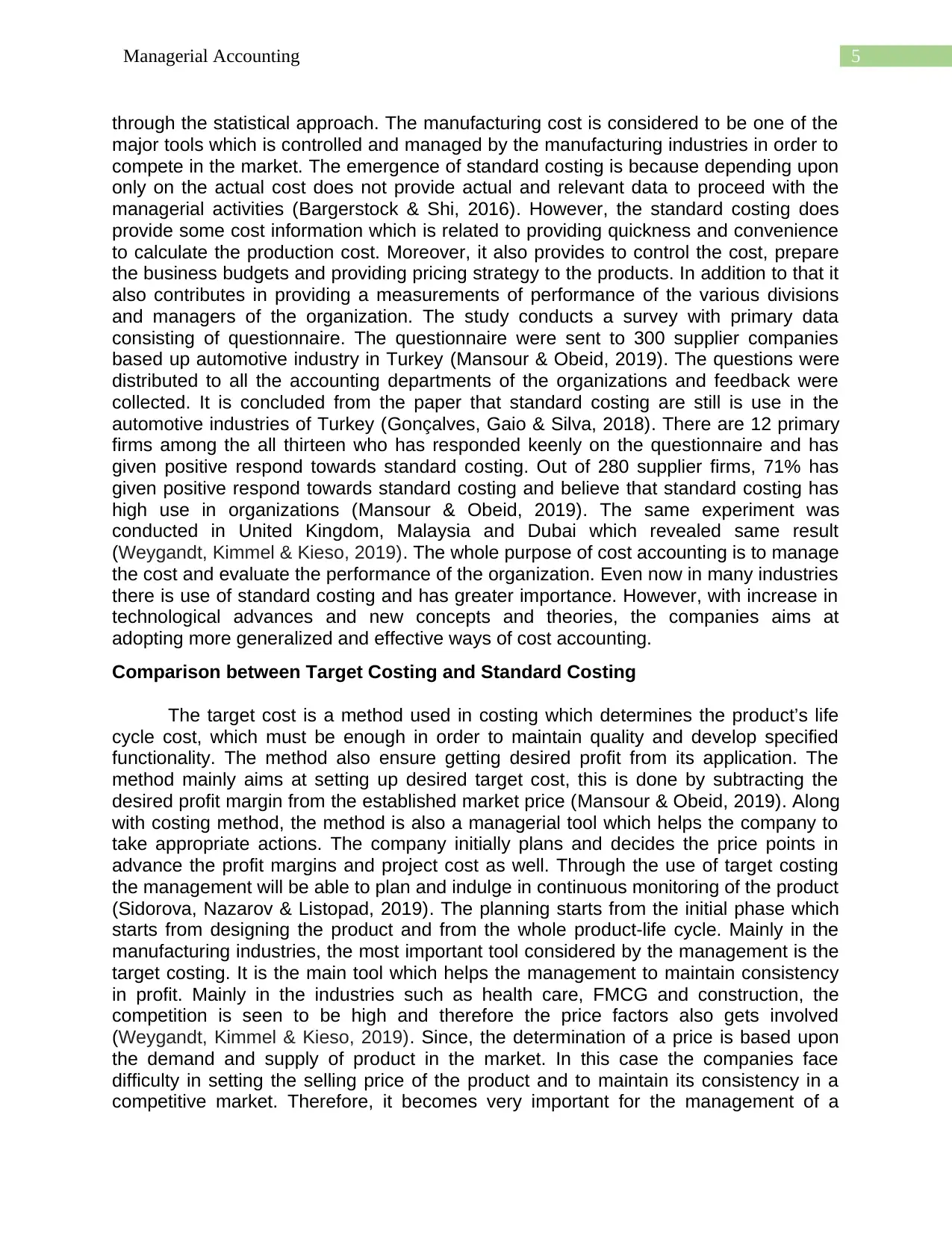
5Managerial Accounting
through the statistical approach. The manufacturing cost is considered to be one of the
major tools which is controlled and managed by the manufacturing industries in order to
compete in the market. The emergence of standard costing is because depending upon
only on the actual cost does not provide actual and relevant data to proceed with the
managerial activities (Bargerstock & Shi, 2016). However, the standard costing does
provide some cost information which is related to providing quickness and convenience
to calculate the production cost. Moreover, it also provides to control the cost, prepare
the business budgets and providing pricing strategy to the products. In addition to that it
also contributes in providing a measurements of performance of the various divisions
and managers of the organization. The study conducts a survey with primary data
consisting of questionnaire. The questionnaire were sent to 300 supplier companies
based up automotive industry in Turkey (Mansour & Obeid, 2019). The questions were
distributed to all the accounting departments of the organizations and feedback were
collected. It is concluded from the paper that standard costing are still is use in the
automotive industries of Turkey (Gonçalves, Gaio & Silva, 2018). There are 12 primary
firms among the all thirteen who has responded keenly on the questionnaire and has
given positive respond towards standard costing. Out of 280 supplier firms, 71% has
given positive respond towards standard costing and believe that standard costing has
high use in organizations (Mansour & Obeid, 2019). The same experiment was
conducted in United Kingdom, Malaysia and Dubai which revealed same result
(Weygandt, Kimmel & Kieso, 2019). The whole purpose of cost accounting is to manage
the cost and evaluate the performance of the organization. Even now in many industries
there is use of standard costing and has greater importance. However, with increase in
technological advances and new concepts and theories, the companies aims at
adopting more generalized and effective ways of cost accounting.
Comparison between Target Costing and Standard Costing
The target cost is a method used in costing which determines the product’s life
cycle cost, which must be enough in order to maintain quality and develop specified
functionality. The method also ensure getting desired profit from its application. The
method mainly aims at setting up desired target cost, this is done by subtracting the
desired profit margin from the established market price (Mansour & Obeid, 2019). Along
with costing method, the method is also a managerial tool which helps the company to
take appropriate actions. The company initially plans and decides the price points in
advance the profit margins and project cost as well. Through the use of target costing
the management will be able to plan and indulge in continuous monitoring of the product
(Sidorova, Nazarov & Listopad, 2019). The planning starts from the initial phase which
starts from designing the product and from the whole product-life cycle. Mainly in the
manufacturing industries, the most important tool considered by the management is the
target costing. It is the main tool which helps the management to maintain consistency
in profit. Mainly in the industries such as health care, FMCG and construction, the
competition is seen to be high and therefore the price factors also gets involved
(Weygandt, Kimmel & Kieso, 2019). Since, the determination of a price is based upon
the demand and supply of product in the market. In this case the companies face
difficulty in setting the selling price of the product and to maintain its consistency in a
competitive market. Therefore, it becomes very important for the management of a
through the statistical approach. The manufacturing cost is considered to be one of the
major tools which is controlled and managed by the manufacturing industries in order to
compete in the market. The emergence of standard costing is because depending upon
only on the actual cost does not provide actual and relevant data to proceed with the
managerial activities (Bargerstock & Shi, 2016). However, the standard costing does
provide some cost information which is related to providing quickness and convenience
to calculate the production cost. Moreover, it also provides to control the cost, prepare
the business budgets and providing pricing strategy to the products. In addition to that it
also contributes in providing a measurements of performance of the various divisions
and managers of the organization. The study conducts a survey with primary data
consisting of questionnaire. The questionnaire were sent to 300 supplier companies
based up automotive industry in Turkey (Mansour & Obeid, 2019). The questions were
distributed to all the accounting departments of the organizations and feedback were
collected. It is concluded from the paper that standard costing are still is use in the
automotive industries of Turkey (Gonçalves, Gaio & Silva, 2018). There are 12 primary
firms among the all thirteen who has responded keenly on the questionnaire and has
given positive respond towards standard costing. Out of 280 supplier firms, 71% has
given positive respond towards standard costing and believe that standard costing has
high use in organizations (Mansour & Obeid, 2019). The same experiment was
conducted in United Kingdom, Malaysia and Dubai which revealed same result
(Weygandt, Kimmel & Kieso, 2019). The whole purpose of cost accounting is to manage
the cost and evaluate the performance of the organization. Even now in many industries
there is use of standard costing and has greater importance. However, with increase in
technological advances and new concepts and theories, the companies aims at
adopting more generalized and effective ways of cost accounting.
Comparison between Target Costing and Standard Costing
The target cost is a method used in costing which determines the product’s life
cycle cost, which must be enough in order to maintain quality and develop specified
functionality. The method also ensure getting desired profit from its application. The
method mainly aims at setting up desired target cost, this is done by subtracting the
desired profit margin from the established market price (Mansour & Obeid, 2019). Along
with costing method, the method is also a managerial tool which helps the company to
take appropriate actions. The company initially plans and decides the price points in
advance the profit margins and project cost as well. Through the use of target costing
the management will be able to plan and indulge in continuous monitoring of the product
(Sidorova, Nazarov & Listopad, 2019). The planning starts from the initial phase which
starts from designing the product and from the whole product-life cycle. Mainly in the
manufacturing industries, the most important tool considered by the management is the
target costing. It is the main tool which helps the management to maintain consistency
in profit. Mainly in the industries such as health care, FMCG and construction, the
competition is seen to be high and therefore the price factors also gets involved
(Weygandt, Kimmel & Kieso, 2019). Since, the determination of a price is based upon
the demand and supply of product in the market. In this case the companies face
difficulty in setting the selling price of the product and to maintain its consistency in a
competitive market. Therefore, it becomes very important for the management of a
⊘ This is a preview!⊘
Do you want full access?
Subscribe today to unlock all pages.

Trusted by 1+ million students worldwide
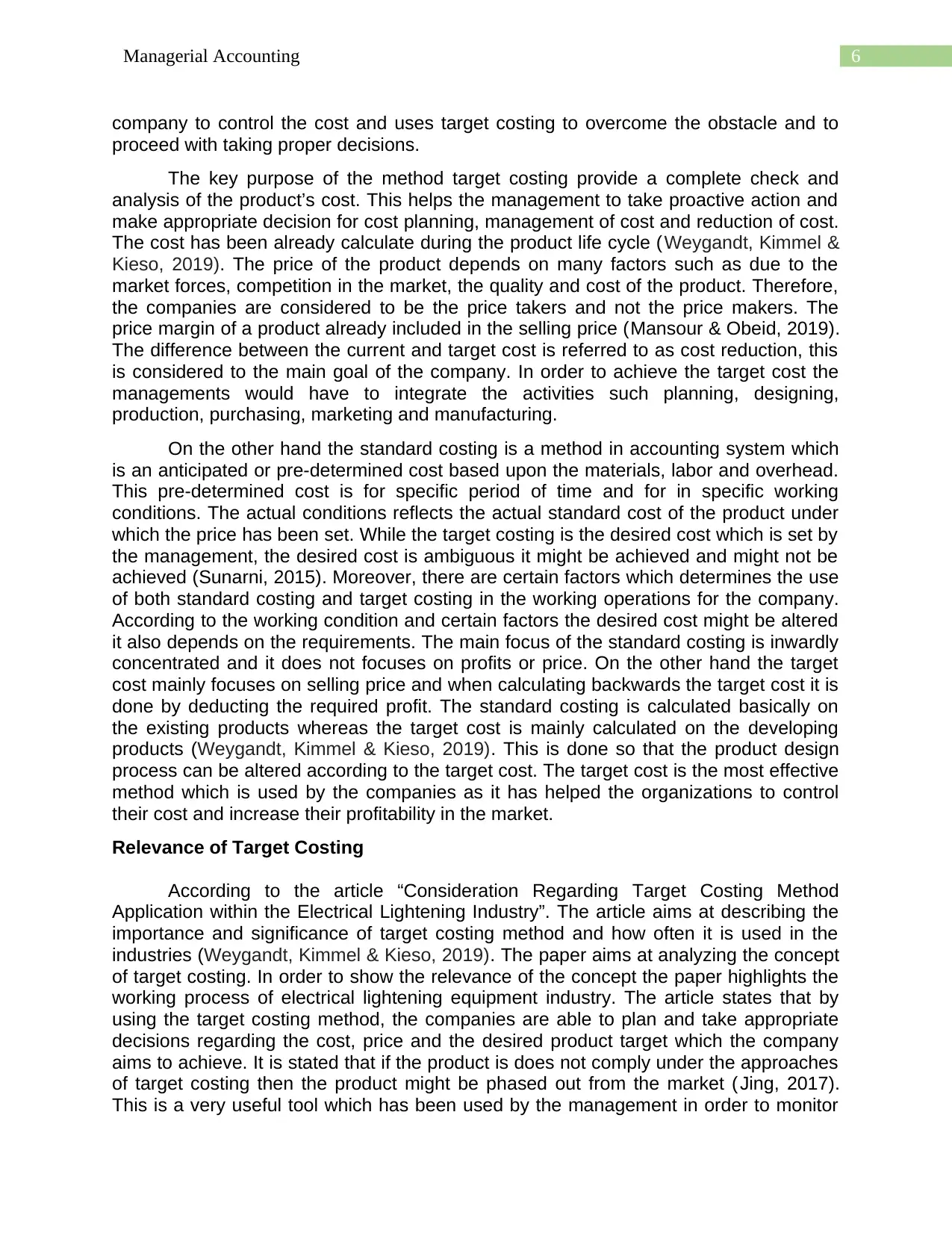
6Managerial Accounting
company to control the cost and uses target costing to overcome the obstacle and to
proceed with taking proper decisions.
The key purpose of the method target costing provide a complete check and
analysis of the product’s cost. This helps the management to take proactive action and
make appropriate decision for cost planning, management of cost and reduction of cost.
The cost has been already calculate during the product life cycle (Weygandt, Kimmel &
Kieso, 2019). The price of the product depends on many factors such as due to the
market forces, competition in the market, the quality and cost of the product. Therefore,
the companies are considered to be the price takers and not the price makers. The
price margin of a product already included in the selling price (Mansour & Obeid, 2019).
The difference between the current and target cost is referred to as cost reduction, this
is considered to the main goal of the company. In order to achieve the target cost the
managements would have to integrate the activities such planning, designing,
production, purchasing, marketing and manufacturing.
On the other hand the standard costing is a method in accounting system which
is an anticipated or pre-determined cost based upon the materials, labor and overhead.
This pre-determined cost is for specific period of time and for in specific working
conditions. The actual conditions reflects the actual standard cost of the product under
which the price has been set. While the target costing is the desired cost which is set by
the management, the desired cost is ambiguous it might be achieved and might not be
achieved (Sunarni, 2015). Moreover, there are certain factors which determines the use
of both standard costing and target costing in the working operations for the company.
According to the working condition and certain factors the desired cost might be altered
it also depends on the requirements. The main focus of the standard costing is inwardly
concentrated and it does not focuses on profits or price. On the other hand the target
cost mainly focuses on selling price and when calculating backwards the target cost it is
done by deducting the required profit. The standard costing is calculated basically on
the existing products whereas the target cost is mainly calculated on the developing
products (Weygandt, Kimmel & Kieso, 2019). This is done so that the product design
process can be altered according to the target cost. The target cost is the most effective
method which is used by the companies as it has helped the organizations to control
their cost and increase their profitability in the market.
Relevance of Target Costing
According to the article “Consideration Regarding Target Costing Method
Application within the Electrical Lightening Industry”. The article aims at describing the
importance and significance of target costing method and how often it is used in the
industries (Weygandt, Kimmel & Kieso, 2019). The paper aims at analyzing the concept
of target costing. In order to show the relevance of the concept the paper highlights the
working process of electrical lightening equipment industry. The article states that by
using the target costing method, the companies are able to plan and take appropriate
decisions regarding the cost, price and the desired product target which the company
aims to achieve. It is stated that if the product is does not comply under the approaches
of target costing then the product might be phased out from the market ( Jing, 2017).
This is a very useful tool which has been used by the management in order to monitor
company to control the cost and uses target costing to overcome the obstacle and to
proceed with taking proper decisions.
The key purpose of the method target costing provide a complete check and
analysis of the product’s cost. This helps the management to take proactive action and
make appropriate decision for cost planning, management of cost and reduction of cost.
The cost has been already calculate during the product life cycle (Weygandt, Kimmel &
Kieso, 2019). The price of the product depends on many factors such as due to the
market forces, competition in the market, the quality and cost of the product. Therefore,
the companies are considered to be the price takers and not the price makers. The
price margin of a product already included in the selling price (Mansour & Obeid, 2019).
The difference between the current and target cost is referred to as cost reduction, this
is considered to the main goal of the company. In order to achieve the target cost the
managements would have to integrate the activities such planning, designing,
production, purchasing, marketing and manufacturing.
On the other hand the standard costing is a method in accounting system which
is an anticipated or pre-determined cost based upon the materials, labor and overhead.
This pre-determined cost is for specific period of time and for in specific working
conditions. The actual conditions reflects the actual standard cost of the product under
which the price has been set. While the target costing is the desired cost which is set by
the management, the desired cost is ambiguous it might be achieved and might not be
achieved (Sunarni, 2015). Moreover, there are certain factors which determines the use
of both standard costing and target costing in the working operations for the company.
According to the working condition and certain factors the desired cost might be altered
it also depends on the requirements. The main focus of the standard costing is inwardly
concentrated and it does not focuses on profits or price. On the other hand the target
cost mainly focuses on selling price and when calculating backwards the target cost it is
done by deducting the required profit. The standard costing is calculated basically on
the existing products whereas the target cost is mainly calculated on the developing
products (Weygandt, Kimmel & Kieso, 2019). This is done so that the product design
process can be altered according to the target cost. The target cost is the most effective
method which is used by the companies as it has helped the organizations to control
their cost and increase their profitability in the market.
Relevance of Target Costing
According to the article “Consideration Regarding Target Costing Method
Application within the Electrical Lightening Industry”. The article aims at describing the
importance and significance of target costing method and how often it is used in the
industries (Weygandt, Kimmel & Kieso, 2019). The paper aims at analyzing the concept
of target costing. In order to show the relevance of the concept the paper highlights the
working process of electrical lightening equipment industry. The article states that by
using the target costing method, the companies are able to plan and take appropriate
decisions regarding the cost, price and the desired product target which the company
aims to achieve. It is stated that if the product is does not comply under the approaches
of target costing then the product might be phased out from the market ( Jing, 2017).
This is a very useful tool which has been used by the management in order to monitor
Paraphrase This Document
Need a fresh take? Get an instant paraphrase of this document with our AI Paraphraser

7Managerial Accounting
the product pricings strategy and its sustainability in the market as well. It basically
deals with product life cycle and designing the product (Sidorova, Nazarov & Listopad,
2019). The main purpose of the target costing is that the manufacturers or the
producers will be able to control and monitor the different stages of a product life cycle.
This is done by the help of target costing as it will analyze the overall cost of the
product. This also depends upon the competition in the market, cost of the product and
demand and supply in the market. The article subjects the use of target costing in
electrical lightening industry and the method of cost calculation. This ensures the
company that the new product are being sold at a profitable prize throughout its life
cycle. The target costing tracks the cost of the product over the lifecycle and aims at
comparing the forecasted costs and achievement set by the management. The article
reviews through the production trend of the company and by analyzing the cost of the
product. The various indicators which are considered for the analysis are conditions
forecast, selling prize and the profit rate (Talebnia, et al., 2017). It is concluded from the
whole analysis that target costing is able to make effective and significant changes in
the organizations. The management with the use of target costing is able to operate the
accounting part. It has helped the manager to control and set a profitable target by
analyzing the prices of previous years (Weygandt, Kimmel & Kieso, 2019). In the
competitive business environment the prices are the major factor through which a
products takes over a market and therefore, analysis is important. Cost planning is
highly important for any business to make their product sustain in the market. Therefore,
the business highly depends upon target costing system and however, through the
analysis it is found to be highly effective in the business.
Conclusion
It is inferred from the above discussion that standard costing and target costing
systems being the traditional system in accounting still has relevance and significance
in modern day industries. According to the articles and their studies it has been derived
that there is significant use of standard costing and target costing in the industries and
the management finds it easy to use those system in their organizations. The systems
are effectively used in the industries in order increase the productivity and profitability of
the business. The management accounting has contributed immensely in the decision
making of the company. It has been observed that the company has been using the
concept of standard costing and target costing in their working operations and which
has resulted in positive outcome within the operations. It has been observed that
standard costing and target costing are highly valued in the companies. The costing
techniques has improved the operational structure of the business and aims at forming
a structured pricing strategy for the products. The above discussion reveals the
advantages of standard costing and target costing. The various analysis done in the
articles shows that both standard costing and target costing are effectively used in the
industries. The automotive industry effectively uses standard costing and the
management is able to make appropriate decisions for the company. The standard
costing effectively works considering the manufacturing products and hence, the
management is able to control the operations of the business. On the other hand, in
electric lightening the new product’s cost analysis is done through target costing and the
company is highly benefited by the application of the method. Therefore, it can be said
the product pricings strategy and its sustainability in the market as well. It basically
deals with product life cycle and designing the product (Sidorova, Nazarov & Listopad,
2019). The main purpose of the target costing is that the manufacturers or the
producers will be able to control and monitor the different stages of a product life cycle.
This is done by the help of target costing as it will analyze the overall cost of the
product. This also depends upon the competition in the market, cost of the product and
demand and supply in the market. The article subjects the use of target costing in
electrical lightening industry and the method of cost calculation. This ensures the
company that the new product are being sold at a profitable prize throughout its life
cycle. The target costing tracks the cost of the product over the lifecycle and aims at
comparing the forecasted costs and achievement set by the management. The article
reviews through the production trend of the company and by analyzing the cost of the
product. The various indicators which are considered for the analysis are conditions
forecast, selling prize and the profit rate (Talebnia, et al., 2017). It is concluded from the
whole analysis that target costing is able to make effective and significant changes in
the organizations. The management with the use of target costing is able to operate the
accounting part. It has helped the manager to control and set a profitable target by
analyzing the prices of previous years (Weygandt, Kimmel & Kieso, 2019). In the
competitive business environment the prices are the major factor through which a
products takes over a market and therefore, analysis is important. Cost planning is
highly important for any business to make their product sustain in the market. Therefore,
the business highly depends upon target costing system and however, through the
analysis it is found to be highly effective in the business.
Conclusion
It is inferred from the above discussion that standard costing and target costing
systems being the traditional system in accounting still has relevance and significance
in modern day industries. According to the articles and their studies it has been derived
that there is significant use of standard costing and target costing in the industries and
the management finds it easy to use those system in their organizations. The systems
are effectively used in the industries in order increase the productivity and profitability of
the business. The management accounting has contributed immensely in the decision
making of the company. It has been observed that the company has been using the
concept of standard costing and target costing in their working operations and which
has resulted in positive outcome within the operations. It has been observed that
standard costing and target costing are highly valued in the companies. The costing
techniques has improved the operational structure of the business and aims at forming
a structured pricing strategy for the products. The above discussion reveals the
advantages of standard costing and target costing. The various analysis done in the
articles shows that both standard costing and target costing are effectively used in the
industries. The automotive industry effectively uses standard costing and the
management is able to make appropriate decisions for the company. The standard
costing effectively works considering the manufacturing products and hence, the
management is able to control the operations of the business. On the other hand, in
electric lightening the new product’s cost analysis is done through target costing and the
company is highly benefited by the application of the method. Therefore, it can be said
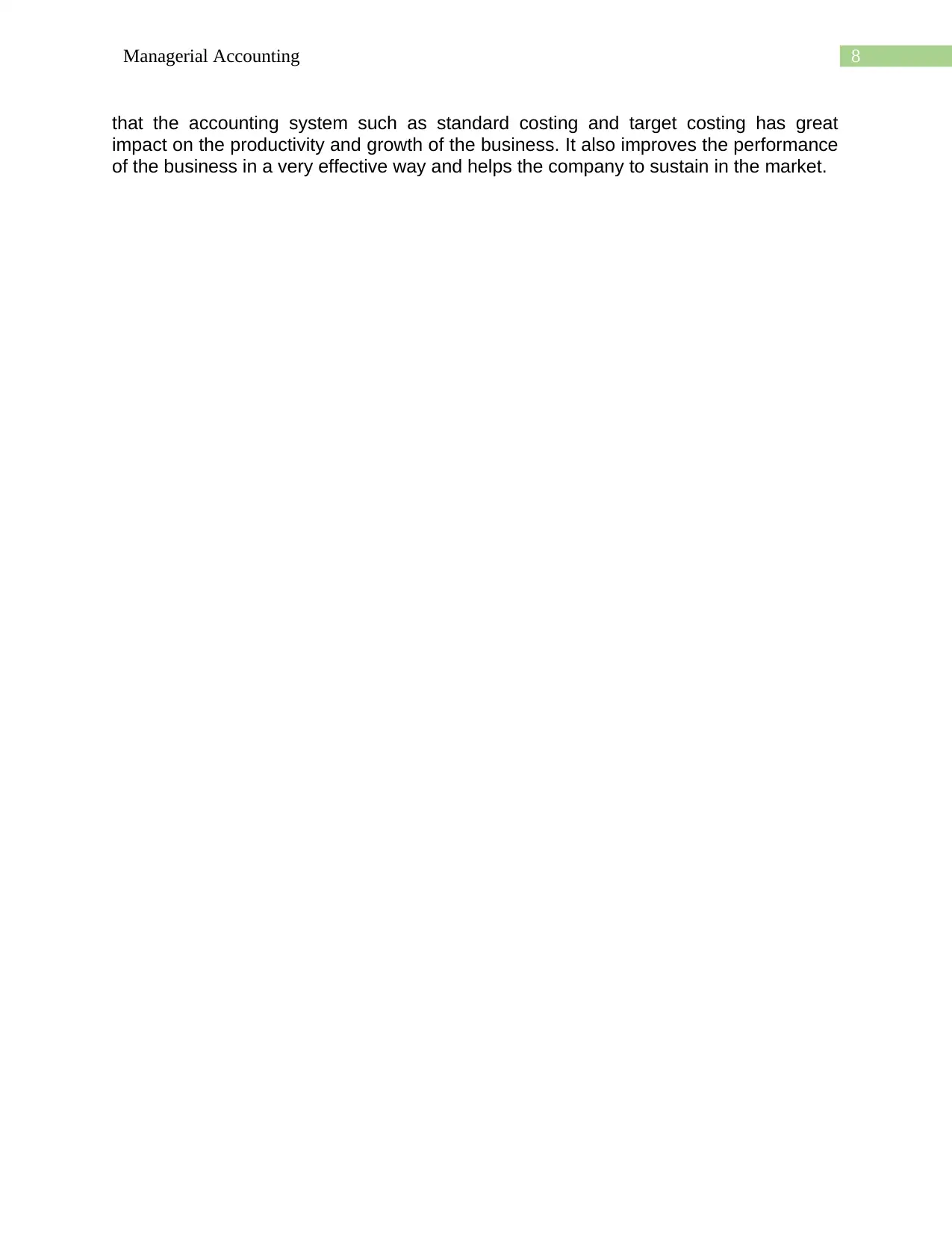
8Managerial Accounting
that the accounting system such as standard costing and target costing has great
impact on the productivity and growth of the business. It also improves the performance
of the business in a very effective way and helps the company to sustain in the market.
that the accounting system such as standard costing and target costing has great
impact on the productivity and growth of the business. It also improves the performance
of the business in a very effective way and helps the company to sustain in the market.
⊘ This is a preview!⊘
Do you want full access?
Subscribe today to unlock all pages.

Trusted by 1+ million students worldwide
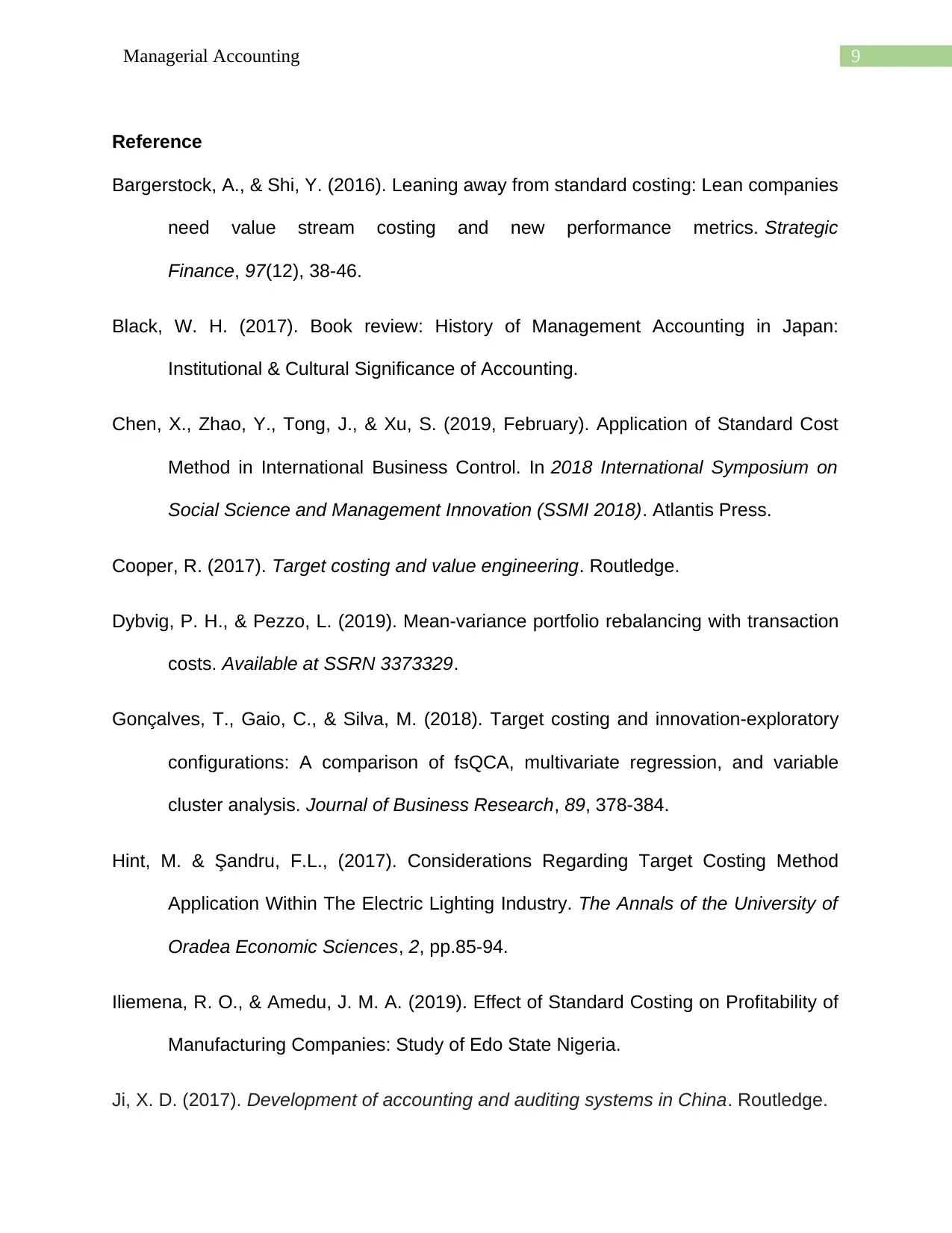
9Managerial Accounting
Reference
Bargerstock, A., & Shi, Y. (2016). Leaning away from standard costing: Lean companies
need value stream costing and new performance metrics. Strategic
Finance, 97(12), 38-46.
Black, W. H. (2017). Book review: History of Management Accounting in Japan:
Institutional & Cultural Significance of Accounting.
Chen, X., Zhao, Y., Tong, J., & Xu, S. (2019, February). Application of Standard Cost
Method in International Business Control. In 2018 International Symposium on
Social Science and Management Innovation (SSMI 2018). Atlantis Press.
Cooper, R. (2017). Target costing and value engineering. Routledge.
Dybvig, P. H., & Pezzo, L. (2019). Mean-variance portfolio rebalancing with transaction
costs. Available at SSRN 3373329.
Gonçalves, T., Gaio, C., & Silva, M. (2018). Target costing and innovation-exploratory
configurations: A comparison of fsQCA, multivariate regression, and variable
cluster analysis. Journal of Business Research, 89, 378-384.
Hint, M. & Şandru, F.L., (2017). Considerations Regarding Target Costing Method
Application Within The Electric Lighting Industry. The Annals of the University of
Oradea Economic Sciences, 2, pp.85-94.
Iliemena, R. O., & Amedu, J. M. A. (2019). Effect of Standard Costing on Profitability of
Manufacturing Companies: Study of Edo State Nigeria.
Ji, X. D. (2017). Development of accounting and auditing systems in China. Routledge.
Reference
Bargerstock, A., & Shi, Y. (2016). Leaning away from standard costing: Lean companies
need value stream costing and new performance metrics. Strategic
Finance, 97(12), 38-46.
Black, W. H. (2017). Book review: History of Management Accounting in Japan:
Institutional & Cultural Significance of Accounting.
Chen, X., Zhao, Y., Tong, J., & Xu, S. (2019, February). Application of Standard Cost
Method in International Business Control. In 2018 International Symposium on
Social Science and Management Innovation (SSMI 2018). Atlantis Press.
Cooper, R. (2017). Target costing and value engineering. Routledge.
Dybvig, P. H., & Pezzo, L. (2019). Mean-variance portfolio rebalancing with transaction
costs. Available at SSRN 3373329.
Gonçalves, T., Gaio, C., & Silva, M. (2018). Target costing and innovation-exploratory
configurations: A comparison of fsQCA, multivariate regression, and variable
cluster analysis. Journal of Business Research, 89, 378-384.
Hint, M. & Şandru, F.L., (2017). Considerations Regarding Target Costing Method
Application Within The Electric Lighting Industry. The Annals of the University of
Oradea Economic Sciences, 2, pp.85-94.
Iliemena, R. O., & Amedu, J. M. A. (2019). Effect of Standard Costing on Profitability of
Manufacturing Companies: Study of Edo State Nigeria.
Ji, X. D. (2017). Development of accounting and auditing systems in China. Routledge.
Paraphrase This Document
Need a fresh take? Get an instant paraphrase of this document with our AI Paraphraser
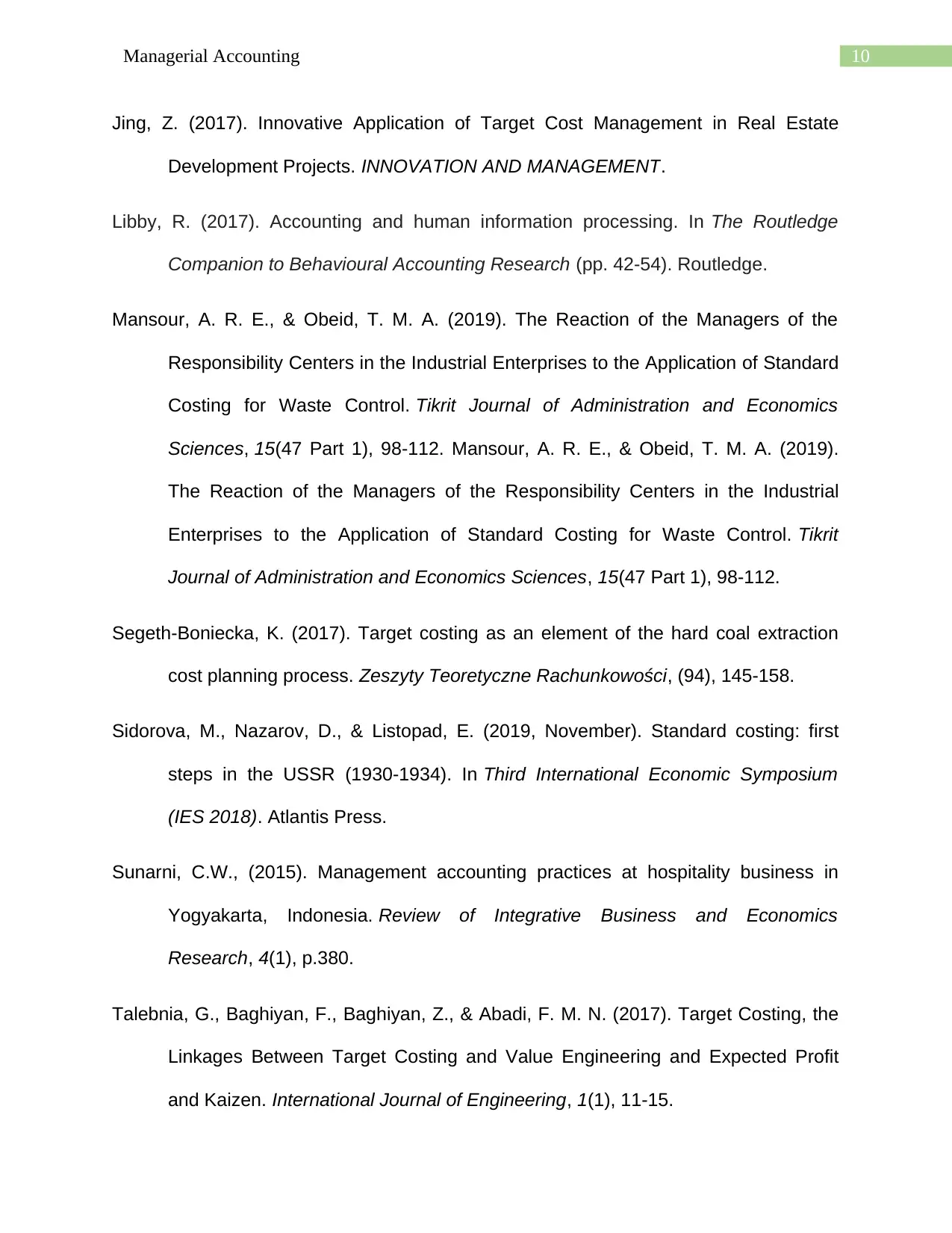
10Managerial Accounting
Jing, Z. (2017). Innovative Application of Target Cost Management in Real Estate
Development Projects. INNOVATION AND MANAGEMENT.
Libby, R. (2017). Accounting and human information processing. In The Routledge
Companion to Behavioural Accounting Research (pp. 42-54). Routledge.
Mansour, A. R. E., & Obeid, T. M. A. (2019). The Reaction of the Managers of the
Responsibility Centers in the Industrial Enterprises to the Application of Standard
Costing for Waste Control. Tikrit Journal of Administration and Economics
Sciences, 15(47 Part 1), 98-112. Mansour, A. R. E., & Obeid, T. M. A. (2019).
The Reaction of the Managers of the Responsibility Centers in the Industrial
Enterprises to the Application of Standard Costing for Waste Control. Tikrit
Journal of Administration and Economics Sciences, 15(47 Part 1), 98-112.
Segeth-Boniecka, K. (2017). Target costing as an element of the hard coal extraction
cost planning process. Zeszyty Teoretyczne Rachunkowości, (94), 145-158.
Sidorova, M., Nazarov, D., & Listopad, E. (2019, November). Standard costing: first
steps in the USSR (1930-1934). In Third International Economic Symposium
(IES 2018). Atlantis Press.
Sunarni, C.W., (2015). Management accounting practices at hospitality business in
Yogyakarta, Indonesia. Review of Integrative Business and Economics
Research, 4(1), p.380.
Talebnia, G., Baghiyan, F., Baghiyan, Z., & Abadi, F. M. N. (2017). Target Costing, the
Linkages Between Target Costing and Value Engineering and Expected Profit
and Kaizen. International Journal of Engineering, 1(1), 11-15.
Jing, Z. (2017). Innovative Application of Target Cost Management in Real Estate
Development Projects. INNOVATION AND MANAGEMENT.
Libby, R. (2017). Accounting and human information processing. In The Routledge
Companion to Behavioural Accounting Research (pp. 42-54). Routledge.
Mansour, A. R. E., & Obeid, T. M. A. (2019). The Reaction of the Managers of the
Responsibility Centers in the Industrial Enterprises to the Application of Standard
Costing for Waste Control. Tikrit Journal of Administration and Economics
Sciences, 15(47 Part 1), 98-112. Mansour, A. R. E., & Obeid, T. M. A. (2019).
The Reaction of the Managers of the Responsibility Centers in the Industrial
Enterprises to the Application of Standard Costing for Waste Control. Tikrit
Journal of Administration and Economics Sciences, 15(47 Part 1), 98-112.
Segeth-Boniecka, K. (2017). Target costing as an element of the hard coal extraction
cost planning process. Zeszyty Teoretyczne Rachunkowości, (94), 145-158.
Sidorova, M., Nazarov, D., & Listopad, E. (2019, November). Standard costing: first
steps in the USSR (1930-1934). In Third International Economic Symposium
(IES 2018). Atlantis Press.
Sunarni, C.W., (2015). Management accounting practices at hospitality business in
Yogyakarta, Indonesia. Review of Integrative Business and Economics
Research, 4(1), p.380.
Talebnia, G., Baghiyan, F., Baghiyan, Z., & Abadi, F. M. N. (2017). Target Costing, the
Linkages Between Target Costing and Value Engineering and Expected Profit
and Kaizen. International Journal of Engineering, 1(1), 11-15.
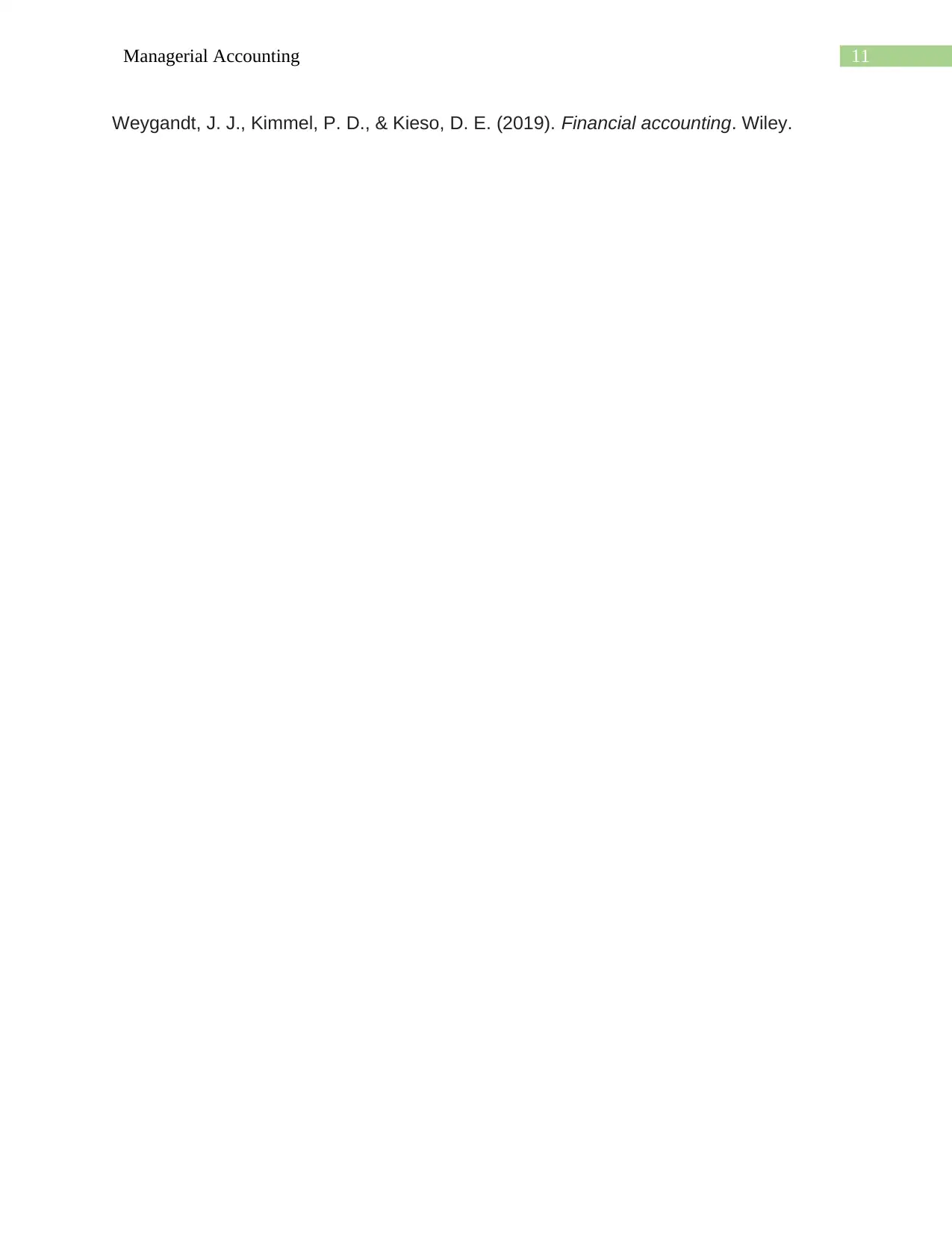
11Managerial Accounting
Weygandt, J. J., Kimmel, P. D., & Kieso, D. E. (2019). Financial accounting. Wiley.
Weygandt, J. J., Kimmel, P. D., & Kieso, D. E. (2019). Financial accounting. Wiley.
⊘ This is a preview!⊘
Do you want full access?
Subscribe today to unlock all pages.

Trusted by 1+ million students worldwide
1 out of 12
Related Documents
Your All-in-One AI-Powered Toolkit for Academic Success.
+13062052269
info@desklib.com
Available 24*7 on WhatsApp / Email
![[object Object]](/_next/static/media/star-bottom.7253800d.svg)
Unlock your academic potential
Copyright © 2020–2025 A2Z Services. All Rights Reserved. Developed and managed by ZUCOL.





